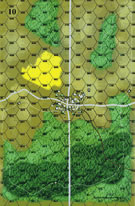| Author |
Matt W
|
| Method |
Solo |
| Victor |
Draw |
| Play Date |
2012-09-28 |
| Language |
English |
| Scenario |
HbnS012
|
After three plays of HbnS using the SA and Schutzbund troops with their abysmal morale I figured that it would be fun to use the Landwehr units and see if they would be any better. Their morale is better and the situation is one where they do not have to stand up to repeated DF or artillery fire (it is a night scenario so while the action is sharp it is not usually prolonged and the -1 column on fire attacks helps a lot).
The Germans realize their weakness and set up completely in the town. They are aided by remarkably good leaders (two have +2 morale ratings and there are multiple fire ratings as well). They do not attempt any defense of the surrounding area.
The Austrians bring an elite group against the German reservists and expect to have the same kind of success that they had against the SA or Schutzbund. Their approach to the German held town was reckless, depending on their superior morale to fend off the results of the opportunity fire. This was a mistake as the Germans were able to generate strong fire groups using the HMGs and the fire ratings of their leaders to cause losses.
The Austrians broke off some of their assault, leaving in place only one contested town hex and retreated to one hex off to lick their wounds and prepare a response. The night kept them out of sight but still quite close so that the delay in recovering was minimal.
The Germans then got a case of hubris of their own and advanced to push against the Austrians in order to keep them from recovering and attacking again. This led to a weakening of the German force sufficient to permit a late game assault against the town by the recovered Austrians with enough force to contest three hexes of the town at game's end.
It is hard to say whether this one would be as competitive without the tremendous German leadership I got in my draw. While on one hand it would have blunted the initial success of the Germans it would also have caused them to be more conservative and not come out of the town to challenge the Austrians. I think in the end this scenario will be hard fought nearly all of the time. I give it a "4"
|




 HbnS011
HbnS011 















